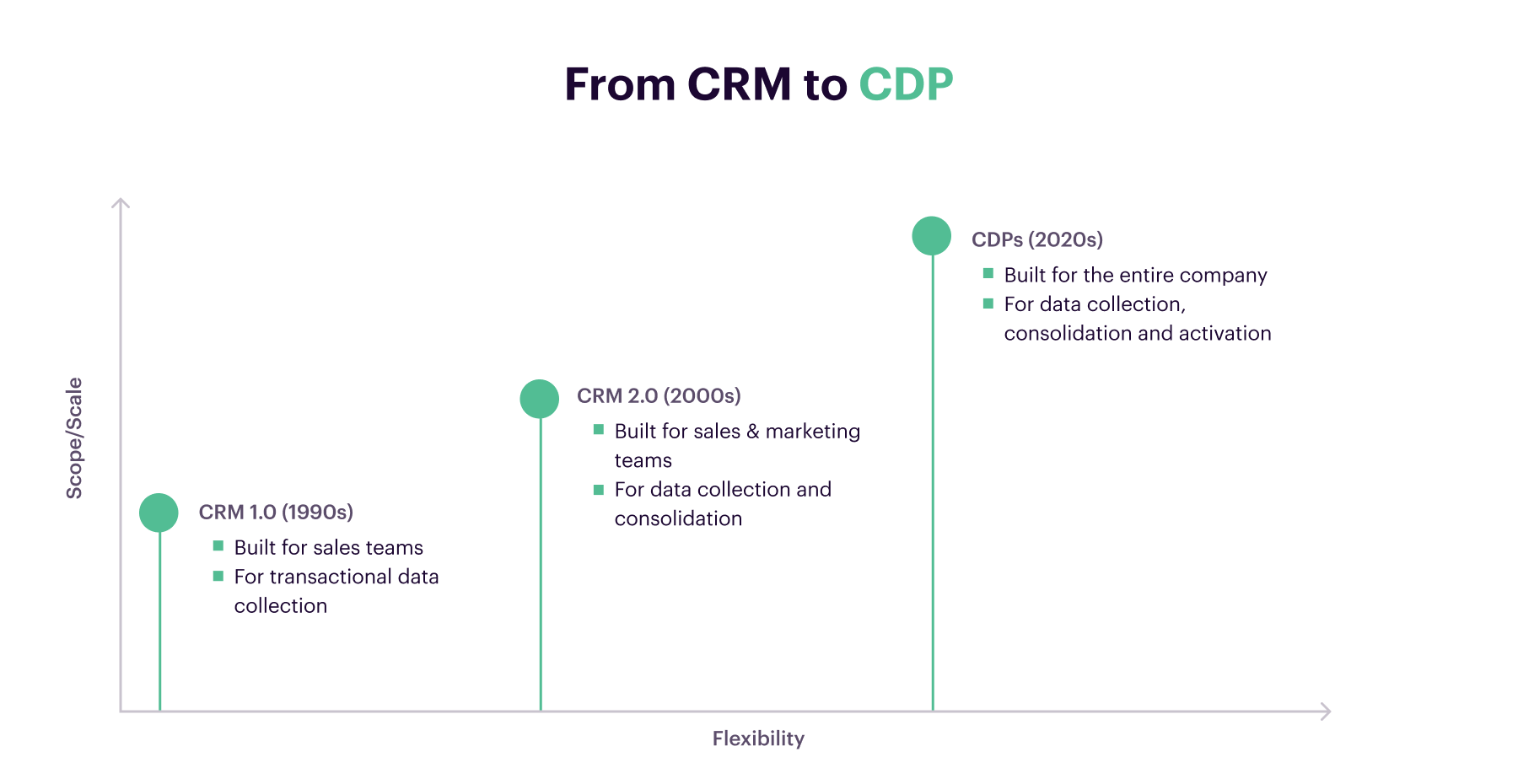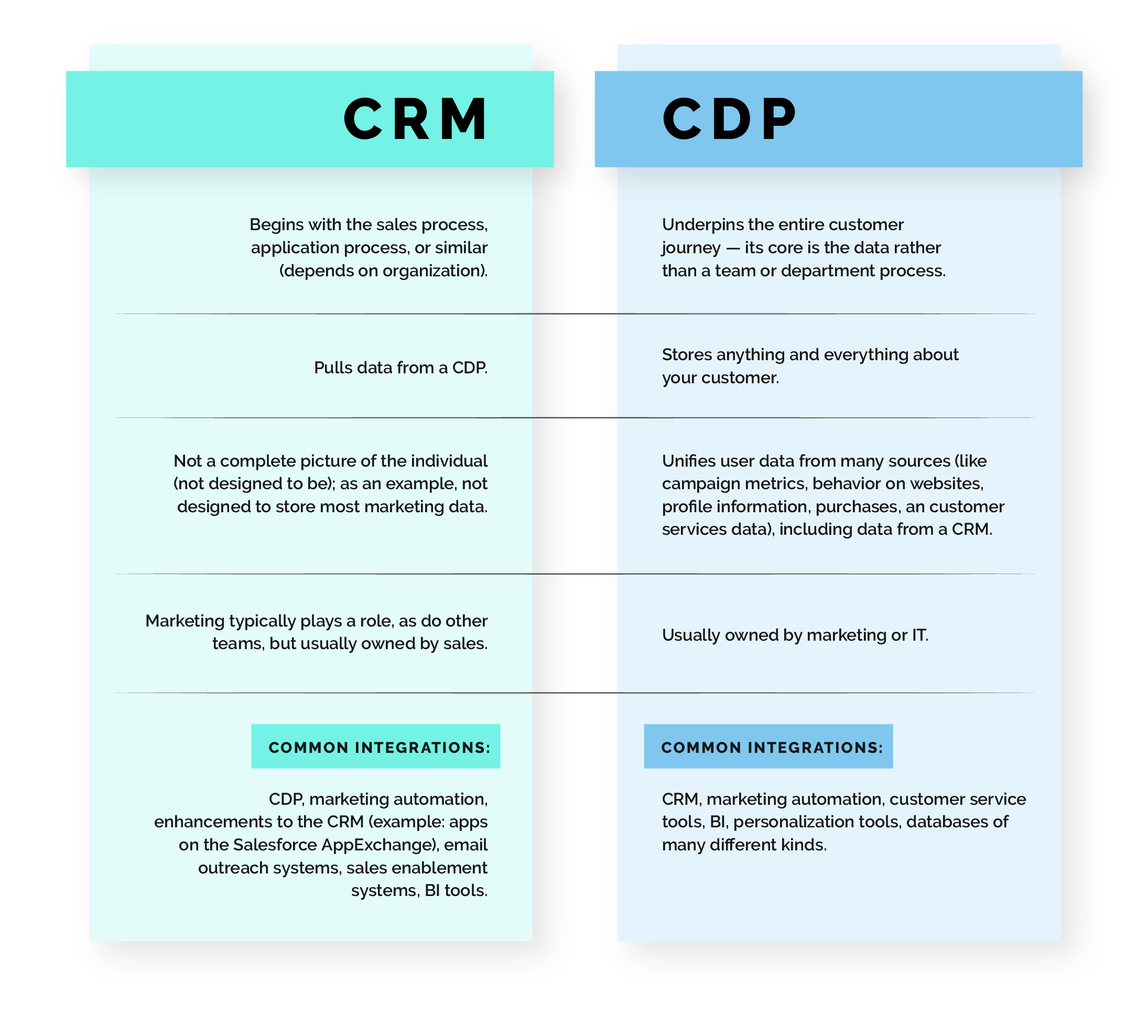Customer Relationship Management (CRM) and Customer Data Platforms (CDP) are two essential tools for businesses. Both manage customer data, but they serve different purposes.
Understanding the differences between CRM and CDP can help businesses choose the right tool. A CRM system focuses on managing customer interactions and sales. It helps track leads, manage customer relationships, and drive sales efforts. On the other hand, a CDP collects data from various sources to create a unified customer profile.
It integrates data to provide a complete view of customer behavior. This comparison will clarify their unique features and benefits, enabling you to make an informed decision for your business needs.
What Is A Crm?
A Customer Relationship Management (CRM) system helps businesses manage interactions with customers. It centralizes customer data in one place. This makes it easier to track and analyze customer interactions.
Core Functions
CRM systems offer several core functions. These include:
- Contact Management: Store and manage customer contact details.
- Lead Management: Track potential customers and sales opportunities.
- Sales Automation: Automate sales processes like follow-ups and scheduling.
- Customer Support: Track and manage customer support tickets.
- Reporting and Analytics: Generate reports on sales and customer activities.
Popular Crm Tools
| Tool Name | Key Features |
|---|---|
| Salesforce | Highly customizable, robust analytics, and integrations. |
| HubSpot CRM | Free tier available, easy to use, and marketing tools. |
| Zoho CRM | Affordable, automation features, and multi-channel support. |
| Pipedrive | Visual sales pipeline, simple interface, and email tracking. |
These tools help businesses improve customer relationships. They also boost sales efficiency and provide valuable insights.

Credit: segment.com
What Is A Cdp?
A Customer Data Platform (CDP) is a software system. It collects, organizes, and manages customer data. Businesses use this data to improve customer experiences. A CDP creates a single, unified customer view. This helps in personalizing marketing efforts.
CDPs gather data from various sources. This includes websites, apps, social media, and more. The data is then processed and stored in a central location. This ensures that all customer information is up-to-date and accurate. Businesses can then use this data to create targeted marketing campaigns.
CDPs differ from CRM systems. CRMs focus on managing customer relationships and sales processes. CDPs focus on gathering and analyzing customer data. This makes CDPs essential for data-driven marketing strategies.
Core Functions
CDPs have several core functions. First, they collect data from multiple sources. This includes online and offline channels. Second, they unify this data into a single customer profile. Third, they allow for easy data access and analysis. Fourth, they help in creating personalized marketing campaigns.
CDPs also offer data segmentation. This means dividing customers into different groups. These groups are based on behavior, demographics, and other factors. This helps businesses target specific audiences with relevant content.
Popular Cdp Tools
There are many popular CDP tools available. Some of the most well-known include Segment, Tealium, and BlueConic. Segment is known for its ease of use and flexibility. Tealium offers powerful data integration capabilities. BlueConic excels in real-time customer data management.
Other notable CDP tools include Exponea, Lytics, and Treasure Data. Exponea provides advanced analytics and AI-driven insights. Lytics focuses on customer journey orchestration. Treasure Data offers robust data processing and storage solutions.
Key Differences
Understanding the key differences between CRM and CDP is crucial for businesses. Both tools help manage customer relationships, but they serve different purposes. This section will explore these differences, focusing on data management and customer insights.
Data Management
CRM systems focus on managing customer interactions. They store contact details, track sales activities, and log customer service issues. CRMs are excellent for handling day-to-day customer operations. They help sales teams stay organized.
On the other hand, CDPs collect data from various sources. They integrate data from websites, mobile apps, and other channels. This data is then unified into a single customer profile. CDPs provide a comprehensive view of customer behavior across all touchpoints. They store both structured and unstructured data.
Customer Insights
CRMs provide insights based on direct interactions. They help understand sales performance, customer service efficiency, and campaign effectiveness. The insights are often limited to data entered by the user. This can include emails, call logs, and meeting notes.
CDPs offer deeper customer insights. They analyze behavioral data, purchase history, and web activity. CDPs use this data to create detailed customer segments. These insights help businesses tailor personalized marketing campaigns. They predict future customer behavior and preferences.

Credit: www.phase2technology.com
Use Cases For Crms
Customer Relationship Management (CRM) systems offer versatile solutions for businesses. They help in enhancing sales processes, managing customer data, and improving service delivery. Below are two main use cases for CRMs.
Sales Tracking
CRMs provide robust sales tracking tools. These tools help sales teams monitor the entire sales cycle. From lead generation to deal closure, everything is recorded.
- Track leads and opportunities
- Monitor sales team performance
- Forecast future sales
By using these tracking features, businesses can identify which sales strategies work. They can also pinpoint areas needing improvement.
Customer Relationship Management
CRMs store detailed customer information. This data includes contact details, purchase history, and customer interactions.
- Maintain customer profiles
- Track customer interactions
- Manage customer service requests
With this information, businesses can offer personalized services. They can also resolve issues quickly, improving customer satisfaction.
Using a CRM helps businesses build stronger customer relationships. It enables better communication and long-term loyalty.
Use Cases For Cdps
Customer Data Platforms (CDPs) offer a powerful way to manage customer data. They help businesses understand their customers better. CDPs gather data from various sources and unify it. This makes it easier to use customer data for different purposes. Here are some common use cases for CDPs.
Unified Customer Profiles
CDPs create unified customer profiles by combining data from multiple sources. This includes data from websites, social media, and emails. A unified profile gives a complete view of each customer. Businesses can see what customers like and how they behave. This helps in making more informed decisions.
A CDP can also update profiles in real-time. This means businesses always have the latest information. It helps in providing better customer service. For example, if a customer contacts support, the agent can see their recent activities. This allows for a more personalized response.
Personalized Marketing
CDPs enable personalized marketing by using detailed customer profiles. Marketers can segment their audience based on different criteria. This could be purchase history, browsing behavior, or interests. Personalized messages resonate more with customers. They are more likely to engage and convert.
Businesses can also use CDPs to automate marketing campaigns. They can send the right message at the right time. For instance, a customer who abandoned a cart can receive a reminder email. Or, a loyal customer can get special offers. Personalized marketing increases customer satisfaction and loyalty.
| CDP Features | Benefits |
|---|---|
| Unified Customer Profiles | Complete view of customers |
| Real-time Updates | Always up-to-date information |
| Audience Segmentation | Targeted marketing campaigns |
| Automated Campaigns | Timely and relevant messages |
Integration With Other Systems
Integrating with other systems is crucial for efficient business operations. Both CRM and CDP systems offer unique integration capabilities. These integrations enhance data flow, streamline processes, and improve customer interactions. Let’s explore how CRM and CDP systems integrate with other platforms.
Crm Integrations
Customer Relationship Management (CRM) systems focus on managing customer interactions. They integrate with various tools to boost productivity and data accuracy. Here are some common integrations:
- Email Marketing Platforms: Sync contact lists and automate email campaigns.
- Sales Tools: Connect with sales platforms for tracking deals and performance.
- Social Media: Engage with customers on social channels directly from the CRM.
- Customer Support: Integrate with helpdesk software to manage tickets and support requests.
- Calendar Apps: Schedule meetings and follow-ups seamlessly.
These integrations ensure a unified view of customer interactions. They help teams work efficiently and provide better customer service.
Cdp Integrations
Customer Data Platforms (CDP) focus on collecting and unifying customer data. They integrate with various systems to centralize data and create a single customer view. Here are some common integrations:
- Analytics Tools: Gather data from web analytics for deeper insights.
- Advertising Platforms: Sync customer data for targeted ad campaigns.
- Data Warehouses: Centralize data from multiple sources for analysis.
- Marketing Automation: Personalize marketing messages based on unified data.
- CRM Systems: Share customer data between CDP and CRM for a complete view.
These integrations help create a comprehensive customer profile. They enable personalized marketing and improved decision-making.
Choosing The Right Tool
Choosing the right tool between a CRM (Customer Relationship Management) and a CDP (Customer Data Platform) depends on various factors. Understanding your business needs, budget, and goals is crucial. This section will guide you through key considerations.
Business Needs Assessment
First, evaluate your business requirements. CRMs are ideal for managing customer interactions. They help sales teams track leads and close deals. If your focus is on improving customer service, a CRM might be the best fit.
CDPs, on the other hand, collect data from multiple sources. They create a unified customer profile. This is useful for marketing teams. It helps them deliver personalized campaigns. If your goal is to enhance marketing efforts, a CDP could be more beneficial.
Cost Considerations
Next, consider the costs. CRMs typically charge per user. This can add up quickly for large teams. Some CRMs offer tiered pricing based on features. This allows you to choose a plan that fits your budget.
CDPs often have a different pricing model. They may charge based on the volume of data. This can be more cost-effective for smaller businesses. But, as data grows, costs can increase. Compare the pricing structures carefully.

Credit: www.simondata.com
Frequently Asked Questions
What Is A Crm?
A CRM, or Customer Relationship Management system, helps manage interactions with customers and prospects. It focuses on sales, marketing, and service. CRM systems store contact information, track sales activities, and manage customer support.
What Is A Cdp?
A CDP, or Customer Data Platform, collects and unifies customer data from various sources. It creates a single, comprehensive customer profile. CDPs help businesses understand customer behavior and personalize marketing efforts.
How Do Crm And Cdp Differ?
CRMs focus on managing customer interactions and sales processes. CDPs focus on collecting and unifying customer data. Both tools enhance customer relationships, but they serve different purposes.
Can Crm And Cdp Work Together?
Yes, CRM and CDP can work together. Integrating both systems provides a comprehensive view of customer interactions and behavior. This integration enhances marketing, sales, and customer service efforts.
Conclusion
Choosing between a CRM and a CDP depends on your business needs. CRMs are great for managing customer relationships. CDPs help in gathering and analyzing customer data. Think about what you need most. Better relationships or deeper insights? Both tools have their strengths.
Understand your goals and select the right tool. This will boost your business efficiency. Always keep your customers in mind. Happy customers mean a successful business.




